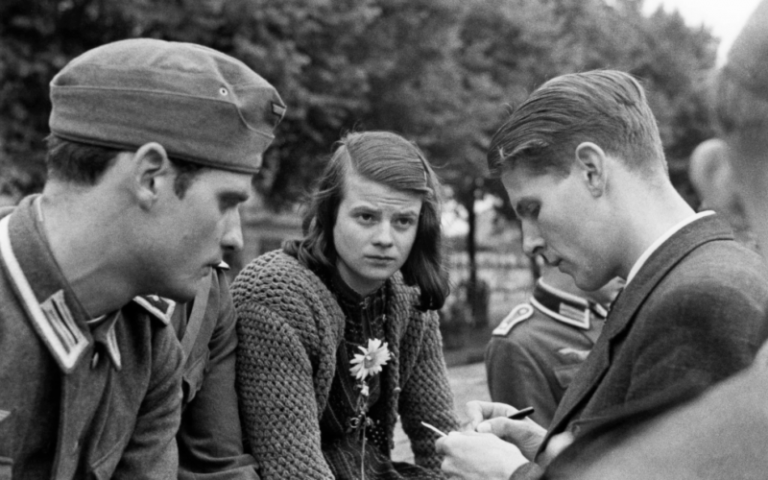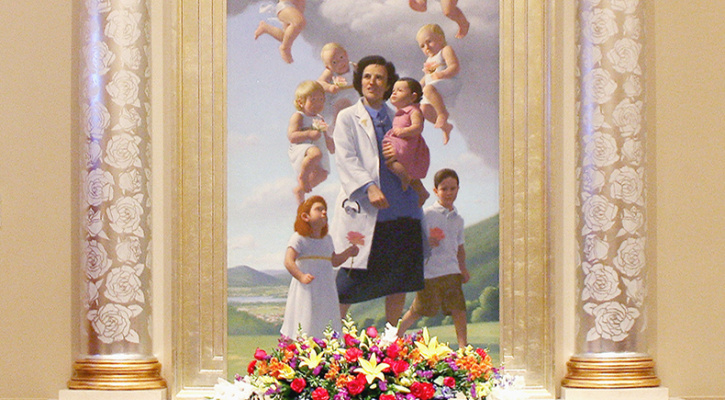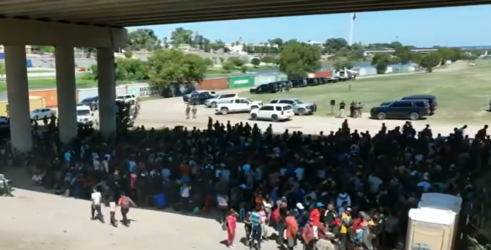I have just been reading Conscience before Conformity, by Paul Shrimpton, published by Gracewing. Subtitled “Hans and Sophie Scholl and the White Rose resistance in Nazi Germany” the book, with its extensive quotations from the letters and diaries of the Scholl siblings, throws much-needed new light on the brave yet seemingly doomed protest (against) Hitler on the part of these two Munich university students and their circle. Having also watched the film Sophie Scholl: The Final Days (2005) it is good to have a more complete and rounded portrait of this extraordinary 21-year-old girl, guillotined along with her 23-year-old brother and a friend on 22 February 1943.
In his preface to the book, Shrimpton states that the Christian faith of those involved in the White Rose movement has been downplayed or ignored. I ask him why this was the case and he explains that some historians of the Nazi period dismissed the religious dimension, regarding “freedom” in merely human terms. Others, such as secular Jews, while praising the students for their “heroic condemnation of the Holocaust, fail to grapple with the Christian identity of the protagonists.”
The book describes the lively, cultured and Christian background of the Scholl siblings. I am keen to know what influence their parents, Robert and Magdalena, had over their children. Shrimpton sees their influence as “complementary”, pointing out that Magdalena, a former nurse, was “a devout Lutheran who nurtured the Christian faith of their five children, encouraging them to read the Bible and instilling in them a strong social conscience.”
Her husband Robert, on the other hand, “was a self-confident businessman; as a pacifist, he had refused to fight in the Great War and from the early 1930s was fiercely anti-Nazi.” At first, the young Scholls were inspired by Hitler’s rhetoric about helping the fatherland achieve greatness “but over time Robert’s explanations convinced them of the lies at the heart of Nazism.” He adds that the Scholl family home “became a magnet for kindred spirits” and reminds me that both parents encouraged their children to read widely, take an interest in art and music, “as well as outdoor activities such as hiking and camping.”
Shrimpton points out that Robert Scholl’s favourite quotation was “Allen Gewalten zum Trutz” -“Stand firm against the powers that be” (Goethe) – and it was adopted as the family motto. After dinner he would sometimes leave the table early, saying “Now if you will excuse me, I will go and earn a jail sentence” – a euphemism for listening to forbidden radio stations such as the BBC.
How influential does Shrimpton think Bishop Clemens von Galen’s sermon of 1941, denouncing the Nazi euthanasia programme, was for the Scholls? He explains that they all knew about the T4 euthanasia programme as Magdalena had heard about it from former nursing colleagues. Inge Scholl, the oldest daughter, recalled that her brother Hans “was deeply impressed by von Galen’s straightforward but profound act of opposition and that he told her, “Finally a man has had the courage to speak out.”
Shrimpton also adds that the duplication and dissemination of von Galen’s sermons “seems to have triggered the idea of using pamphlets as a way of expressing non-violent opposition to the regime which would be very hard for the Gestapo to trace.”
In the book I note that the White Rose circle was familiar with JH Newman’s four sermons on the Anti-Christ, brought to their notice by their mentor, the Catholic writer Theodor Haecker. What part did they play in the Scholl’s resistance activities? Shrimpton believes they were “a pivotal text for Haecker’s thesis about Christianity in the Third Reich and the apostasy of the German people.” He points to the fact that on 10 July 1942 Haecker read to a group of students from his theology of history, The Christian and History; “This examines the role of divine providence in time and takes from Newman the idea that there are no blind coincidences in the events of history.”
“Haecker spoke of fallen angels, of good and evil, the driving forces of history, of Christ and the Anti-Christ, as well as of the appearance of the Anti-Christ in person in the last days of history.” He comments that “the impulsive and spirited Hans took up this cluster of apocalyptic images and used it to draw up the fourth White Rose leaflet.”
According to Shrimpton, Haecker did not think Hitler “was the Anti-Christ, but a messenger or antitype. But Hans disagreed. He argued that the Anti-Christ had come and was none other than Hitler and he must be overthrown by the German resistance.”
Having read the book, the question arises in my mind: despite their great courage, were the Scholls also foolhardy? Shrimpton reflects that “the potential consequences of their acts of resistance were only part of what motivated the White Rose students. They were primarily motivated by some fundamental urge that the right thing to do was to speak out, regardless of whether this would produce a popular reaction. They became reconciled to the idea that this would mean sacrifice, perhaps of their lives. At the same time, they may have hoped that this sacrifice would have practical effects in the long run. Their attitude was typified by Sophie when she said, “So many are dying for this regime, it is high time that someone died in opposition to it.”
Shrimpton also points out that on 18 February, the distribution of the last leaflet at Munich University, “Hans and Sophie nearly escaped being caught. One possible explanation for their increased risk-taking is that they thought it was better to be caught in a public act of defiance rather than by a tip-off and a knock on the door by the Gestapo.”
He thinks, “They acted with serenity as well as courage and single-mindedness, with faith and lightness of heart and without a trace of fanaticism. This was no suicidal despair: their last act, in prison, was to try to save their friends by assuming full responsibility themselves.”
To round up our interview I am curious to know why, among all the acts of resistance to the Nazis, do Hans and Sophie’s protest stand out? Shrimpton reminds me that the majority of those executed were Left-wing political activists. Hans complained, “It is high time that Christians made up their minds to do something. What are we going to show in the way of resistance, as compared to the Communists for instance, when this terror is over? We will be standing empty-handed. We will have no answer when we are asked, ‘What did you do about it?’”
Shrimpton thinks that the White Rose students stand out because “they were not political activists. They came from well-heeled backgrounds and were highly educated. They appeared model Germans and products of good breeding. It was puzzling to the authorities that students with such impeccable Aryan credentials should be accused of spreading rebellion.”
He believes that the reason why several hundred schools, streets and squares in Germany are named after the two students is “their attractive human qualities, their commitment to non-violent resistance and their willingness to stand up for what was right, even at the risk of their lives and when virtually no-one else was prepared to do so. Now they have the status of martyrs.”
http://www.catholicherald.co.uk/commentandblogs/2018/04/17/the-christians-who-resisted-hitler/







